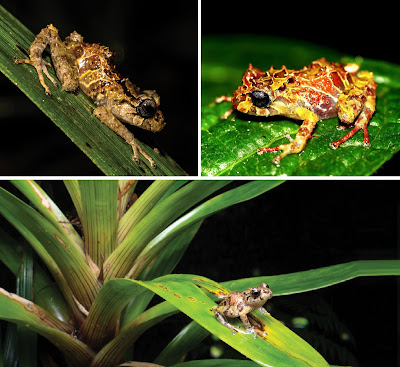 |
| Pristimantis normaewingae Reyes-Puig, Yánez-Muñoz, Libke, Vinueza & Carrión-Olmedo, 2024 Norma Ewing Rain Frog || DOI: 10.3897/evolsyst.8.118855 |
Abstract
Continuous field work on mountains in the upper Pastaza watershed, showed an unexpected cryptic diversity in the recently described Pristimantis anaiae species group. Based on molecular and morphological characters we describe a new frog species from the central region of the eastern Ecuadorian Andes. We present an updated phylogeny for the Pristimantis anaiae species group, based on widely used, ubiquitous, and available genes, three mitochondrial genes (12S rRNA, 16S rRNA, ND1) and RAG1 nuclear gene. Our phylogenetic hypothesis increases genetic diversity of the species group and shows two well-supported subclades. We show the relationships of the new species and include for the first time Pristimantis maryanneae, belonging to a clade related to P. resistencia + P. glendae. Our phylogeny shows that new species, from Cerro Candelaria, is more closely related to P. kunam from Sangay National Park and differs from it by having a less conspicuous dorsolateral row of enlarged tubercles, and sacral oval marks surrounded by thin white pale lines. The new species and two additional undescribed species occur on the south side of the Rio Pastaza Valley, at Cerro Candelaria within the Llanganates – Sangay Ecological Corridor, reflecting the high importance of this area for conservation and understanding of evolution processes in the area, suggesting a probably adaptive radiation zone for the P. anaiae species group.
Key Words: Andes, amphibia, nanopore sequencing, upper Rio Pastaza watershed, Pristimantis normaewingae sp. nov.

Pristimantis normaewingae sp. nov.
English Common name: Norma Ewing Rain Frog.
Spanish Common name: Cutín de Norma Ewing.
Etymology: The specific epithet normaewingae is a noun in the genitive case and is a patronym in honor of Norma Ewing, a passionate conservationist and animal rescue volunteer from United States. Her belief that all species, and especially frogs, are interconnected, is rooted in her early childhood surrounded by nature living and working on a farm. She has always cared for animals of all shapes and sizes. As a volunteer with animal rescues, she was admired for her ability to nurture orphaned and injured animals.
Juan Pablo Reyes-Puig, Mario H. Yánez-Muñoz, Zane Libke, Patricio Vinueza and Julio C. Carrión-Olmedo. 2024. Phylogenetic Diversity of the Pristimantis anaiae species group, with A Description of A New Species of Pristimantis (Anura, Strabomantidae) from Cerro Candelaria, Tungurahua, Ecuador. Evolutionary Systematics. 8(1): 101-118. DOI: 10.3897/evolsyst.8.118855



